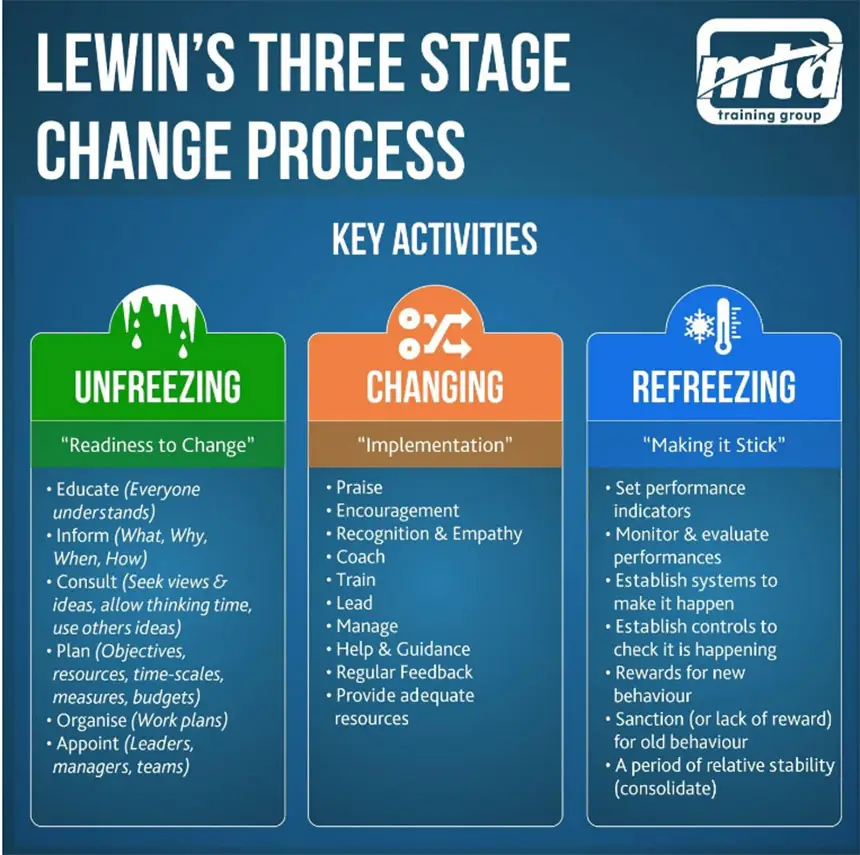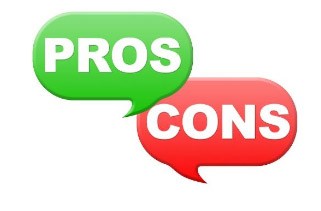🏢 9,000+ Organisations
🏆 6 x L&D/HR Awards
⭐ 4.8/5 Highly Rated
🧠 24 Years' Experience

Change is an inevitable part of running any organisation. However, it’s not always easy to get people on board with changes, even positive ones.
Lewin’s Change Management Model is a simple, effective strategy that can help team leaders and members navigate changes with ease.
This guide outlines the advantages and disadvantages of Lewin’s Change Model and provides real-life examples of how you can implement it.

Lewin’s Change Model was developed by Kurt Lewin, a German American psychologist who studied human social behaviour and group dynamics.
Lewin’s model features three stages that illustrate how people react when they’re faced with change — including changes in the way their workplace runs.
The three stages are as follows:
Understanding the average person’s response to change can help team leaders prepare for upcoming changes. Managers can also use this information to give their employees the tools they need to navigate the changes successfully.

Managing change is always a popular topic that we cover in our Management Training Courses because every organisation is constantly changing and evolving – or it should be anyhow. Before diving into the pros and cons of Lewin’s Change Model, let’s break down the three stages that comprise it in more detail:
In business, the unfreeze stage of Lewin’s Change Model is all about preparing team members to accept that changes must take place. These changes could be financial, organisational, managerial, etc.
When executing the first step of Lewin’s model, managers and leaders must craft a compelling story to explain why the current way of doing things is no longer effective and how change can make things better.
For example, a team leader might reference the company’s steadily declining sales numbers or collection of negative customer satisfaction surveys. They can then use this information to explain the need for a change in the sales team’s approach or the way the customer service team operates.
Often, the Unfreeze stage is the most challenging phase. People naturally get confused or frustrated when they learn they must change the way they do things, and it can take time to get them on board.
If you do an adequate job at convincing people to re-examine the company’s core values or current approach, you can gain buy-in from others and get the engagement needed to bring about legitimate, positive change.
After you’ve obtained buy-in from others and your organisation is ready to change, you’ll move into the second stage — aptly labelled “Change.”
During the Change stage, you’ll start acting and making adjustments to the way your team or business does things.
To succeed during this stage, you must clearly communicate your plans and explain why you’re making certain decisions. You should also focus on short-term wins to keep people motivated and encourage them to continue moving forward with your plan.
A common obstacle that comes up during the change stage has to do with fear. Your team members might feel uncertain about or afraid of your decisions or plans. They may be hesitant to make changes or push back when you suggest they do something differently.
To combat this issue, you must demonstrate why your ideas will be effective and how they will provide long-term benefits to the company (increasing productivity, improving financial performance, etc.). Celebrating milestones and small victories also helps during this stage.
The final stage, Refreeze, solidifies your team, and gets them comfortable with the new status quo. When you progress to this stage, everyone will have bought into the changes and committed to upholding them long-term.
For many managers and leaders, it’s easier to move into this stage when they review what they’ve accomplished, celebrate wins, and address issues that have arisen along the way.
Ideally, at the end of the third stage, your team or organisation will be stronger and better prepared to deal with upcoming challenges.
If you don’t get to the Refreeze stage — meaning employees still haven’t bought into your vision and are resistant to change — you’ll need to go back to one or both previous stages and troubleshoot.
The following are some examples of changes you can make to get your team to the Refreeze stage:
After implementing these steps, you’ll have an easier time gaining team members’ buy-in and getting everyone on the same page.

Lewin’s Change Management Model provides many benefits for managers and team members, including the following:
The simplicity of Lewin’s Change Model is one of its greatest strengths.
If you’re looking for a streamlined, easily understandable strategy to help you and your team manage and adapt to change, this is a good one to consider.
Lewin’s model consists of just three stages, after all, so anyone can figure it out and utilise it. This approach also works for teams of various sizes and in numerous industries.
Lewin’s Change Model is also beneficial because it’s based on human psychology.
Lewin had a clear understanding of how humans’ minds work and how they typically respond to change. He used this information to create a simple model that breaks down human behaviours in easily understandable ways.
Many proponents of this model praise its roots in behavioural psychology. They’ve also noted that human psychology rarely changes. In other words, people generally respond to change today the same way they did decades or centuries ago.
The consistency of human behaviour makes this a sound approach that works across multiple teams, organisations, and industries.
When it’s properly implemented, Lewin’s Change Model does a great job of bringing about sustainable, long-term change.
Lewin understood that it takes time to get people on board with changes to the way their business runs or how they do their jobs. He also understood the importance of gaining buy-in and preparing responses to common objections.
These understandings helped Lewin create a model that allows team leaders and managers to introduce changes, explain the need for them, and guide employees until they’re ready to accept and embrace those changes.
Likely due to its roots in human psychology, Lewin’s Change Management Model also puts people first.
The emphasis on real people and their responses to change makes this approach so effective and beneficial for teams of various types and sizes.
Managers and team leaders who utilise this model will be better prepared to handle potential pushback from employees. They will also have an easier time creating a plan that simplifies the transition period and makes it stress-free for as many people as possible.

Of course, there are also some downsides to Lewin’s Change Management Model. Here are four noteworthy ones to keep in mind:
A common criticism of Lewin’s Change Model is that it’s too simple.
Some managers and team leaders feel that Lewin’s model oversimplifies the way humans respond to change.
Critics argue that the three stages of change aren’t sufficient for adequate change management. They also claim that the model leaves too much room for interpretation, which can lead to managers misunderstanding or misusing it.
On a similar note, critics of Lewin’s Change Model also say that it’s too rigid and prescriptive. They argue that businesses constantly go through changes, which goes against the third stage of Lewin’s Model, Refreeze.
Eventually, the behaviours or strategies that were “refrozen” will need to be unfrozen, and the change model will need to be implemented once again. Critics say that a more flexible final stage would be more effective.
Some also perceive Lewin’s Change Model as combative rather than nurturing or supportive of employees.
The three-step model can easily be used to pit employees against each other. It can create an “us vs them” mentality that divides employees into two groups: Those who are in favour of change and those who oppose it.
Those who favour change are also tasked with winning over those who oppose change, which could also contribute to a more hostile and potentially toxic work environment that creates conflict.
Lewin’s Change Management Model is simple in theory, but it can be complex and time-consuming in practice.
It takes time to gain buy-in from all team members and get everyone on board with changes. It takes even more time to refreeze and get people used to those changes so that they become the status quo.
The lengthy nature of Lewin’s model is inherently problematic. Sustainable change takes time, after all.
However, Lewin’s model is best reserved for long-term projects and permanent changes. For short-term initiatives and quick tasks, a different approach will be more efficient and yield better results.

It’s easier to determine if this model is suitable for you if you have a Lewin’s change model real life example to reference. Here are three examples of how you might use Lewin’s change model in nursing, education, and tech:
Lewin’s Change Management Model is often utilised in hospitals and clinics among nursing staff.
Imagine a situation in which a team of nurses in a hospital are struggling with patient medication management — resulting in patients receiving the wrong medications or the incorrect dosages.
During the Unfreeze stage, nurses and managers acknowledge the problem with patients receiving the wrong medications or dosages.
During the Change stage, the manager will implement a new digital system that simplifies the medication management process and minimises human error. They will provide training to teach the nurses how to use the new system and address questions or concerns along the way.
During the Refreeze stage, nurses and managers will have bought into the new system and will feel comfortable using it. It will become second nature to them and the status quo within the hospital.
Let’s say teachers at a primary school are struggling to communicate with pupils’ parents. When they give pupils messages to deliver to their parents, the messages get lost, and parents are out of the loop.
Teachers acknowledge that this is an issue and that they need a new system (Unfreezing).
They work with the head teacher at the school to create a new email system that sends messages directly to parents. They conduct meetings with parents and offer training systems to get everyone on board and comfortable with the email system (Change).
After a couple of months, the parents and teachers are comfortable with the new system, and fewer miscommunication issues exist (Refreezing).
The movie and TV streaming service Netflix is an excellent example of Lewin’s Change Model in action. When Netflix first started, customers had physical copies of films and TV series delivered to their doors. With the advent of streaming, though, the desire for physical copies began to dwindle.
The powers that be at Netflix acknowledged the problem with the current model (Unfreezing), then implemented a different approach by launching an app and offering access to movies and TV shows on demand (Change).
It took some time for people to get used to the new approach, but it eventually became the norm (Refreezing), and now the Netflix app is on every TV and smart device in the world.
Now that you know more about Lewin’s Change Model strengths and weaknesses and how you can implement it at your company, are you interested in giving it a try?
Remember the guidelines discussed above so you can adequately use Lewin’s Change Management Model and set your team up for the best results.
If you need additional help training your employees or providing resources to get them through an upcoming change, MTD training has many courses available, including online and in-house training options.
Please check out our Team Leader Training and Leadership Development Training for blended programmes. Or if you are looking for digital learning, please check out our ILM Online Course and Online Management Training solutions.

Written by Sean McPheat
CEO of MTD Training and Amazon bestselling author. Sean writes about leadership, business, and personal growth, drawing on 20+ years of experience helping over 9,000 companies improve performance.
Updated on: 23 March, 2023
Related Articles

Search For More 